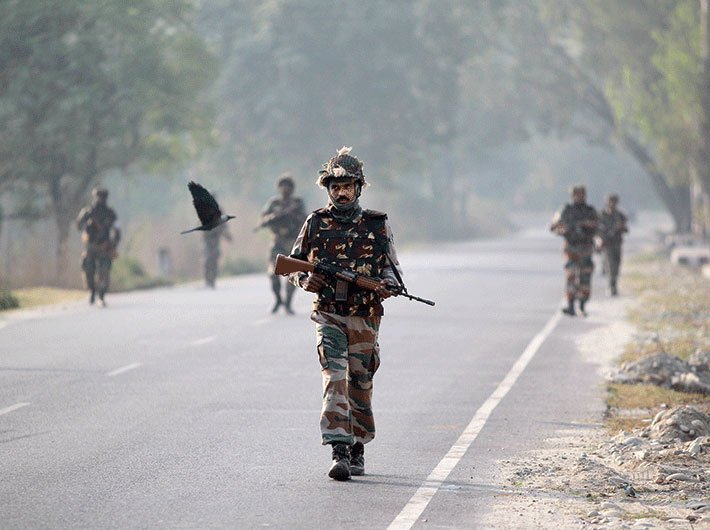As the National Investigation Agency takes over the probe of the attack, many questions remain unanswered
Till a decade ago, Nagrota was a quaint town one would pass through when travelling on the Jammu-Srinagar national highway. From Jammu, it’s an enjoyable drive on the 20-km road snaking along the Ramnagar wildlife sanctuary – a trekkers’ paradise – to Nagrota. For the people of Jammu, the Ramnagar forest, spread over 30 sq km, is the source of ‘manda’, the Dogri word for pleasant breeze that blows over the city in the mornings and evenings during summers.
The only memory people like me, who grew up in Jammu, had of this town was the boring halt at the toll tax plaza and the ochre-painted residential quarters of the army. Till three Pakistani terrorists sneaked inside one of the premises on November 29 this year. In the ensuing encounter, Nagrota shot into news headlines; its soil was soaked in the blood of seven Indian soldiers who died while killing three intruders and rescuing the people trapped in buildings. Nagrota is now the burial place of the three Pakistani terrorists.
The terrorists were first spotted by a major who had just gone out of the premises for his morning walk at 5.30. The trio scaled a 12-foot wall with the help of a rope, used a wire cutter to cut through the concertina wire on the top and roped themselves down on the other side, taking care not to jump and make a sound. As the officer spotted the intruders, who were wearing police uniforms, they panicked and started lobbing grenades to create a smoke screen and scattered in the buildings around. Soon, the army’s quick reaction teams (QRTs) arrived but locating the intruders and estimating their exact number was a challenge.
Meanwhile, the terrorists had entered the mess building and killed four jawans in a single burst of fire. The major called his wife on her cellphone and gave her instructions: bolt the door from inside, and put the dressing table, dining table, chairs and all the sundry pieces of furniture next to it. He further told her to hold their eight-month-old child close to her body and not let him cry under any circumstances and hide under the bed. After erecting an effective barrier for the terrorists, the officer’s wife and her baby remained ducked under the bed in the middle of the house for three hours – till army commandos arrived to her help and shifted them to another room in the same building. The woman holding her baby emerged safely at 12.30 pm along with other people living in the building. By then, three more army men had died while rescuing those trapped.
The major and other senior officers were monitoring the situation in a bunker manned by the CRPF outside the premises. The gun battle with the terrorists, who had taken positions in a building opposite, lasted six hours. The trio was killed and combing operation continued for two days to make sure that there were no more terrorists still lurking around.
Why Nagrota?
Anyone with even a scant idea of terrorists’ modus operandi would tell you that this attack was the most serious of all onslaughts by Pakistan’s non-state actors in Jammu and Kashmir. The place is ensconced in the Trikuta foothills, a good 30 km aerial distance from the nearest point on the border with Pakistan. So far, the terrorists – they are stooges of the Pakistan army, whether they are from the Jamaat-ul-Mujahideen (JuM) or the Lashkar-e-Taiba (LeT) – had targeted military bases located close to the international border and the line of control: in Kaluchak (2002), Pathankot (January) and Uri (September). The very fact that they reached deep inside the territory and attacked an area with a huge army presence should be taken as an indication of Pakistan’s detailed preparations for continuing its proxy war against India.
Nagrota is the headquarters of the 16 Corps of the army, which looks after a huge part of the western border with Pakistan and is the theatre of frequent exchange of fire between India and Pakistan. The northern command headquarters is just 50 km away. Besides, the place has several assets of strategic importance and naming them, even in the era of satellite imagery, could be termed an act of sedition. The fact of the terrorists reaching Nagrota, therefore, signals Pakistan’s due diligence in continuing the proxy war, notwithstanding the fact that its political leadership repeatedly speaks of peace and dialogue.
Nagrota’s location on the crucial arterial highway and its proximity to Jammu, the state’s winter capital, which has emerged as an oasis of peace and a business centre during the 25 years in which Kashmir turned into a hotspot of insurgency, makes this strike look like one of Pakistan’s most well-planned operations. Jammu had enjoyed relative peace and prosperity and this had given the security agencies a sense of complacency about the risk of terrorist attacks. In fact, a day after the Nagrota attack, Amar Ujala, a leading Hindi daily, did a survey of the city and found virtually no police presence on the roads during the night. There was nothing to deter terrorists from moving freely.
Security lapse
Interestingly, the terrorists had gained entry into the army base the same way they did in Pathankot and in Uri. They reached near the army base in the dead of the night. They had used the same tools and techniques to enter. They arrived at the same time in all places – during the change of guard at the entry point. Why could the army not anticipate this and avert it?
“Normally, it’s difficult even for me to access the gate,” says Devinder Singh Rana, Nagrota MLA of the National Conference. “The security at the gate is very tight. I have to stop about 200 metres away and send my guard to seek permission to enter as they don’t allow two persons to walk in together,” says Rana who spent two days at the encounter site to boost the morale of the army and the terrified townsfolk. “The army is very particular about identity cards – even for a legislator. I had to get an identity card made for entry to this place.”
A day before the attack, the BSF had killed three terrorists on the border at Ramnagar and in the follow-up search discovered a 70-foot tunnel from the Pakistan side near Chamliyal, well known for the 320-year-old dargah of a Sufi saint who is revered on both sides of the border. The Nagrota terrorists might have used the same tunnel to enter India and then taken an unprotected and less travelled road via Mansar to descend to Nagrota. The other possibility is that the terrorists might have come from Kashmir via one of the most-protected highways – the Jammu-Srinagar national highway. “All these are speculations and they arise from the turf war between agencies to evade the responsibility for the lapse,” say sources in the state government.
Post-Nagrota, another worry for security mandarins is the high possibility that Pakistan may have cobbled a network of over-ground supporters. The Nagrota attackers wore uniforms of Jammu and Kashmir police, which were probably stitched locally. They were eating fresh chappatis, one of which was found lying on the ground from where they had scaled the wall to gain entry. The army search teams also found the rope they had used to scale the wall and also detected the shoe marks of the intruders. “We believe an agent from Samba is helping them, but we need to do more investigation on the OGWs (over-ground workers),” sources in the J&K government say.
Rana says the local townsfolk could never have provided support to the terrorists. However, he adds, after the attack the army should review its policy of not employing locals in its establishments. “Giving locals a stake in the army’s presence in Nagrota will be in everyone’s interest,” says Rana, who plans to take up the issue with the army top brass.
aasha@governancenow.com
(The article appears in the December 16-31, 2016 issue of Governance Now)

